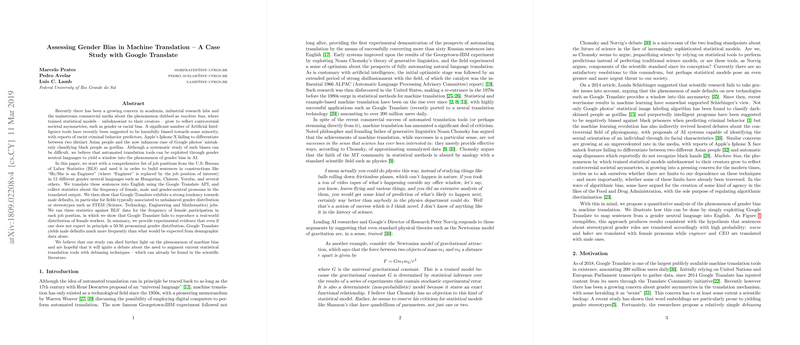Analysis of Gender Bias in Google Translate: A Study of Automated Translation Tools
The paper entitled "Assessing Gender Bias in Machine Translation -- A Case Study with Google Translate" presents an empirical investigation into the gender biases manifested in automated translation tools, focusing specifically on Google Translate. The authors, Marcelo Prates, Pedro Avelar, and Luis C. Lamb from the Federal University of Rio Grande do Sul, conduct a methodical assessment using sentences with job titles translated from gender-neutral languages into English, revealing notable bias towards male pronouns in certain contexts.
Research Framework and Methodology
The authors employ a systematic approach, starting with a comprehensive set of job positions sourced from the U.S. Bureau of Labor Statistics. They construct sentences using these job titles in twelve gender-neutral languages, which are then translated into English using Google Translate. The analysis focuses on the frequency of female, male, and gender-neutral pronouns in the translations. This methodology allows the researchers to probe the translation tool for insights into implicit gender bias, especially in occupations traditionally associated with gender imbalances, such as those in STEM fields.
Strong Findings and Comparisons
Prominent numerical findings indicate that Google Translate disproportionately defaults to male-gendered pronouns in translations, particularly in male-dominated domains like engineering and the sciences. For example, translations related to STEM field occupations show a marked male pronoun bias, with 72% skewed towards male defaults, deviating significantly from real-world gender representations. Such results underscore discrepancies between machine translations and actual gender demographics, as evidenced by the Bureau of Labor Statistics data, which were used as a control to evaluate the expected gender distribution.
Implications and Contributions
This paper is significant for several reasons. First, it highlights the limitations of current AI models that inadvertently propagate societal biases rather than mitigates them. By showcasing how modern translation systems like Google Translate reflect these biases, the research calls attention to the need for debiasing techniques that can be integrated into machine learning models. The authors propose that incorporating debiasing strategies, already present in AI literature, could mitigate these issues without compromising the accuracy of translation systems.
Future Directions and Considerations
The findings of this paper open multiple avenues for further investigation, not only in enhancing the fairness of AI-driven language tools but also in understanding the broader implications of biases in AI applications. The paper reinforces the necessity for the development of AI systems that are not just efficient but also ethically sound, promoting equity and inclusivity. Future research could expand on this by examining other translation models and assessing the effectiveness of proposed debiasing algorithms in practice.
In conclusion, the work by Prates et al. provides critical insights into the challenges of machine bias in automated translation tools. By systematically evaluating Google Translate, the paper offers a quantifiable basis for the discourse on improving AI systems and calls for the deployment of strategies that actively address and reduce gender bias. This is a pivotal contribution to the continuous effort to enhance the societal responsibilities of AI technologies.
